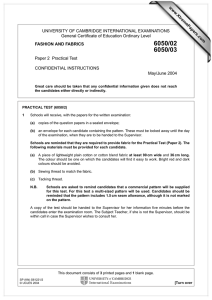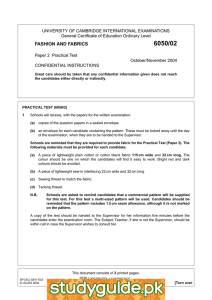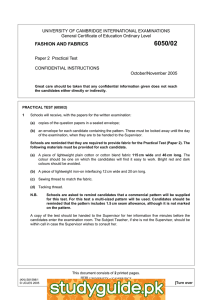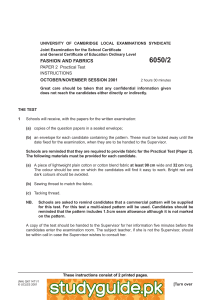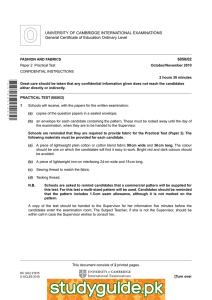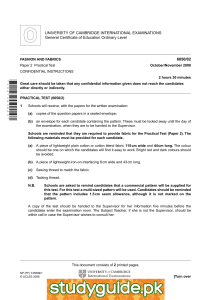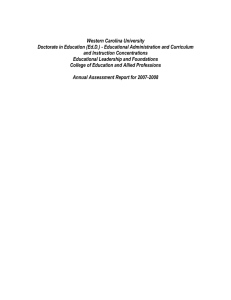6050/02, 6050/03 FASHION AND FABRICS
advertisement
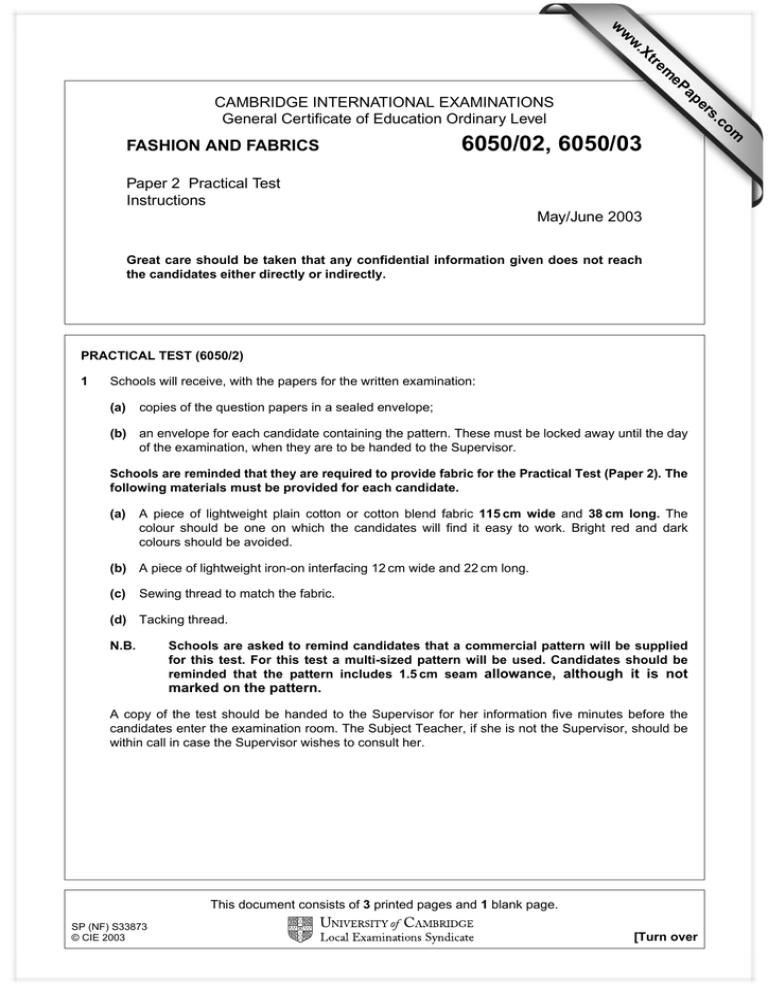
w w ap eP m e tr .X w 6050/02, 6050/03 Paper 2 Practical Test Instructions May/June 2003 Great care should be taken that any confidential information given does not reach the candidates either directly or indirectly. PRACTICAL TEST (6050/2) 1 Schools will receive, with the papers for the written examination: (a) copies of the question papers in a sealed envelope; (b) an envelope for each candidate containing the pattern. These must be locked away until the day of the examination, when they are to be handed to the Supervisor. Schools are reminded that they are required to provide fabric for the Practical Test (Paper 2). The following materials must be provided for each candidate. (a) A piece of lightweight plain cotton or cotton blend fabric 115 cm wide and 38 cm long. The colour should be one on which the candidates will find it easy to work. Bright red and dark colours should be avoided. (b) A piece of lightweight iron-on interfacing 12 cm wide and 22 cm long. (c) Sewing thread to match the fabric. (d) Tacking thread. N.B. Schools are asked to remind candidates that a commercial pattern will be supplied for this test. For this test a multi-sized pattern will be used. Candidates should be reminded that the pattern includes 1.5 cm seam allowance, although it is not marked on the pattern. A copy of the test should be handed to the Supervisor for her information five minutes before the candidates enter the examination room. The Subject Teacher, if she is not the Supervisor, should be within call in case the Supervisor wishes to consult her. This document consists of 3 printed pages and 1 blank page. SP (NF) S33873 © CIE 2003 [Turn over om .c FASHION AND FABRICS s er CAMBRIDGE INTERNATIONAL EXAMINATIONS General Certificate of Education Ordinary Level 2 2 A small label will be printed on the question paper. At the end of the examination, candidates should complete the label showing their name, index and centre number. This is to be cut out and sewn to the work done during the examination, in a position where it does not obscure any process in the work, and should be sewn on single fabric. 3 Each candidate will require the usual sewing equipment, including cutting-out scissors, tacking thread and sewing thread to match the fabric. 4 There should be sufficient table space allowed for each candidate to work freely. At least five sewing machines and two sets of pressing equipment should be provided for every ten candidates. 5 For the examination session, the question paper, pattern and test materials for each candidate should be ready at the table. Candidates should be advised before beginning the test, and reminded 10 minutes before the end of the test, that no unnecessary pins or needles are to be left in their work. This should give time for candidates to tack any part of the test on which they are working but which they cannot complete in the time. 6 When the time for the test has expired all work must cease, except that: (a) owing to the limited amount of pressing equipment available, candidates may press their work, (b) they must sew the label to their work before placing it in the envelope. 7 Candidates must close the envelope by folding the flap inside. 8 The patterns used during the test may be retained by the schools. 9 A first-aid box and reliable clock should be provided. PRACTICAL COURSEWORK (6050/3) 10 All Ordinary level coursework must be completed by 15 March, and it must be collected by the staff on that day. A signed statement from the Principal must be handed to the visiting examiner, certifying that this was done. Incomplete work must be handed in at the same time, and the examiner will consider whether special circumstances should be taken into account when assessing a mark for it. Absence of teaching staff during the year will not be considered sufficient grounds for special allowance. 6050/02/INST/M/J/03 3 11 The coursework will be inspected by a visiting examiner, who will notify schools of the time of her visit. Adequate time will be required for the inspection of each candidate’s work. The Chief Examiner has asked for schools to be informed that it may be a help to the examiner to have access to the room in which the coursework is displayed after school hours. 12 The coursework which is being submitted for inspection by a visiting examiner should be laid out on a table in a convenient and accessible position in a room separate from that in which the Food and Nutrition examination is held. Garments should not be padded with tissue paper or pinned to display apparatus. The work of each candidate should be grouped together. The two garments (or one garment and one article) shown must bear: (i) the candidate’s name and index number; (ii) the date of completion; (iii) the make of pattern used. 13 Only work which has been completed during the year preceding the examination may be shown. 14 No work should be laundered. 15 The teacher is required to certify that the coursework submitted is to the best of her knowledge the candidate’s own work. 16 Where the work of more than one school is displayed, the name of the school must be clearly shown. 6050/02/INST/M/J/03 4 BLANK PAGE 6050/02/INST/M/J/03
